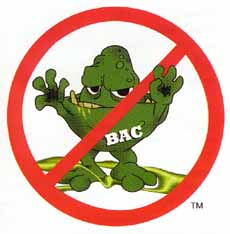|
Although
Americaís food supply is the safest in the world, according to
the U. S. Food and Drug Administration, there are still an
estimated 76 million cases of food-borne illness a year in the
United States. Most healthy people recover quickly without serious
complications, but for the very young, the very old or people with
diseases that suppress the immune system, these illnesses can be
life threatening.
Kathy
Waldo, director of environmental health at the Logan County Health
Department, says that food-borne illnesses, especially those
caused by the salmonella bacteria, often mimic the flu. Symptoms
of salmonellosis, which appear from 6 to 72 hours after eating
contaminated food, include headache, muscle aches, diarrhea,
vomiting, chills, fever, nausea and dehydration.
Symptoms
caused by staphylococcus (staph) bacteria, which appear from two
to four hours after contaminated food is eaten, cause abdominal
cramps, nausea, vomiting and diarrhea, along with headache,
sweating and dehydration. These symptoms, too, might not be
recognized a food-borne illness.
Other
pathogens, such as the E. coli and campylobacter bacteria, can
also cause diarrhea, fever, nausea and abdominal pain.
So
when you think you have a "bug" causing flu-like
symptoms or an intestinal upset, consider that it may be one of
the "bad bugs" that can cause a food-borne illness.
While it is a disturbing thought that the food on your dinner
table may make you sick, there are simple but effective ways to
protect yourself and your family from the discomfort and danger of
food-borne illnesses, Waldo says. She recommends the use of two
simple toolsósoap and a thermometeróand an understanding of
the basics of safe food handling.
Cleanliness
is a cardinal rule, she says. Bacteria, which can make people ill,
can be introduced into food from another food, dirty hands or from
unclean counters, cutting boards and utensils. Because these
bacteria cannot be seen, have no taste and no odor, contaminated
food may smell and taste fine.

Careful
hand washing is a simple safety precaution that too many people
ignore, Waldo believes. "People are very lax about washing
their hands after using the restroom, coughing or sneezing,
changing a babyís diapers or other tasks that will contaminate
their hands with bacteria that can be transferred to food. Before
handling food, people should wash their hands thoroughly with warm
water and soap for at least 20 seconds."
Countertops
where food is prepared should also be kept clean. To kill
bacteria, use a solution of 1Ĺ teaspoons of household
bleach per gallon of water. It is important, also, to wash
dishcloths and sponges regularly in hot soapy water because, when
wet, these materials are good places for bacteria to grow.
Cutting
boards require special attention to keep bacteria from spreading.
Since raw meat, especially poultry, is the food most often
contaminated with disease-carrying organisms, it is important to
clean cutting boards that have been used for raw meat. Use soap
and hot water, plus a germ-killing agent such as the chlorine
solution or a commercial antibacterial product.
It
is best, Waldo says, to use one cutting board for meat and a
different one for ready-to-eat foods so cross-contamination does
not occur. The cutting boards should be made of hard maple or
plastic and not of soft, porous materials. Always keep cooked and
ready-to-eat foods away from raw meats during food preparation.
Raw
vegetables are important to good nutrition, but organisms that
live in soil can also cause illness, Waldo points out. Botulism,
an uncommon but dangerous disease, is caused by bacteria, which
live in soil and grow where there is no oxygen. She recommends
washing vegetables under cold running water and rubbing them
vigorously until all visible dirt has been removed.
Another
way to prevent food-borne illness is to remember the "Danger
Zone." This is the temperature range in which bacteria will
grow most rapidly, between 41 and 140 degrees Fahrenheit. The
longer food is left at this temperature range, the greater the
possibility the bacteria will multiply to the point where they can
cause illness.
|

"Keep
hot food hot and cold food cold," Waldo says. "Hot food
should be kept at 140 degrees Fahrenheit or hotter, and cold food
should be kept at 41 degrees or colder. Donít take chances. Donít
leave food at room temperature. It is best to refrigerate food as
soon as possible.
"Almost
all healthy people carry staph bacteria," she points out.
"If someone coughs or sneezes around food, that food is
likely to be contaminated. What people donít realize is that
staph canít be killed by cooking like most other bacteria, so it
is important not to let food stay at a temperature that allows it
to grow rapidly and reach the danger stage."
Foods
most likely to be involved in staph illnesses are pastries,
custards, salad dressing, sandwiches, sliced meats and
ready-to-eat foods. Leftovers, especially leftovers that have been
allowed to sit out at room temperature, are responsible for the
vast majority of staph food-borne illness, she said.
A
mistake people sometimes make is putting a large amount of hot
food in a big container to refrigerate it, according to Waldo.
"For example, if you make a big pot of stew, it wonít cool
down very fast. If you stick the pot of stew in the refrigerator,
it could still be at 60 or 70 degrees many hours later. Put your
pot of stew in cold water in the sink for a while, or divide up
the stew and refrigerate it in smaller containers."
Unlike
the staph bacteria, most "bad bugs" can be killed by
cooking. Use a thermometer to be sure that meats, poultry and
seafood are cooked to the proper temperatures. The FDA recommends
beef, lamb and pork be cooked to at least 160 F,
poultry to 180 F. Seafood should reach an internal
temperature of 145 F.
Since
poultry is the number one carrier of disease-causing organisms
(the FDA estimates that 60 percent of raw poultry carries some
dangerous bacteria), it is especially important never to eat
poultry that is pink inside. Even rare pink beef carries a higher
risk of illness than beef that is thoroughly cooked.
"Last
year Menard County had a huge outbreak of E. coli," Waldo
remembers. "This normally comes from undercooked ground beef.
There was a big gathering of people, and 250 to 300 of them became
ill."
Eggs,
along with meat, poultry and fish, are often contaminated with the
salmonella bacteria. Eggs should be cooked until the white and
yolk are firm, and foods containing raw eggs, such as homemade
mayonnaise, eggnog, cookie dough and cake batter, should be
avoided.
Even
cooked foods should not be left standing at room temperature for
more than an hour or two. Waldoís rule of thumb for determining
whether food might have been in the "Danger Zone" long
enough to become contaminated is simple: "When in doubt,
throw it out."
It
is important not to store potentially hazardous foods in the
refrigerator too long. The FDA recommends that uncooked chicken,
fish, and ground meats should be kept in the refrigerator no more
than one or two days. Beef steaks and roasts and pork chops and
roasts can be kept three to five days. Milk should be kept no
longer than five days, cheese three to four weeks, and fresh eggs
three weeks.
Food
safety experts say that many cases of food-borne illness go
undiagnosed, and they believe the number of instances is
underreported. Waldo would like anyone who suspects an illness
caused by food or water to contact the health department. However,
she says, most people donít call until they are feeling better,
and then it is often too late to determine what caused the
illness.
"Iíll
get a call from someone saying a group ate at a restaurant and all
got sick. Then I find out the dinner was a week ago and none of
them went to a doctor. The food is gone, the doctor canít get a
stool sample, and thereís nothing we at the health department
can do about it."
She
would like to have such incidents reported as soon as possible so
a doctor can determine if a food-borne illness did occur and the
health department can inspect the restaurant or other site where
the food was served.
[Joan
Crabb]
|



